Right ascension 09 55 52.2 Type I0 Apparent size (V) 11′.2 × 4′.3 Apparent mass ~50 billion M☉ | Declination +69° 40′ 47″ Size ~37,000ly in diameter Distance to Earth 11.42 million light years Magnitude 8.41 Apparent magnitude (V) 8.41 | |
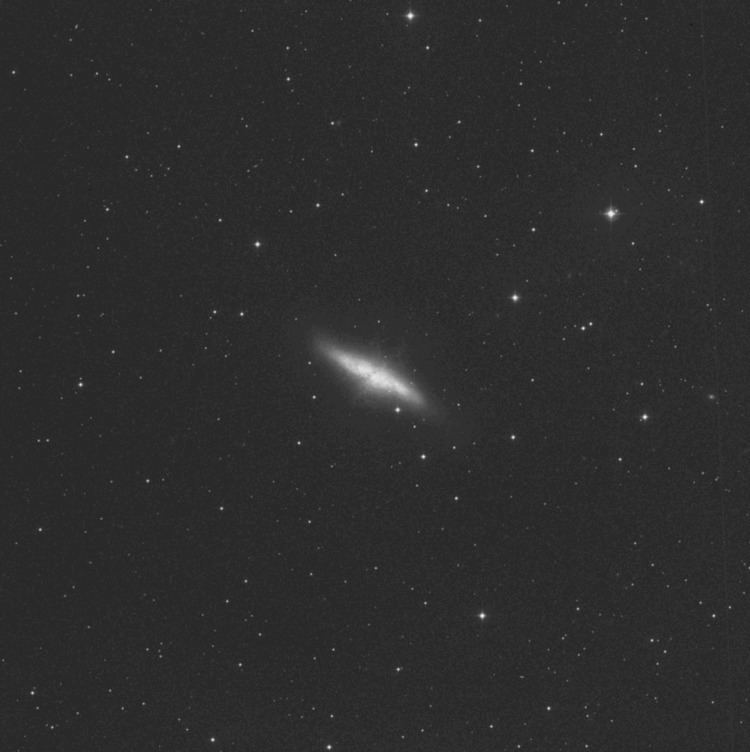 | ||
Redshift 7005203000000000000♠203±4 km/s Coordinates RA 9h 55m 52s | Dec +69° 40′ 47″ Similar Messier 81, Whirlpool Galaxy, Pinwheel Galaxy, Messier 83, Starburst galaxy | ||
M82 messier 82 galaxy observatories chandra spitzer hubble
Messier 82 (also known as NGC 3034, Cigar Galaxy or M82) is a starburst galaxy about 12 million light-years away in the constellation Ursa Major. A member of the M81 Group, it is about five times more luminous than the whole Milky Way and has a center one hundred times more luminous than our galaxy's center. The starburst activity is thought to have been triggered by interaction with neighboring galaxy M81. As the closest starburst galaxy to Earth, M82 is the prototypical example of this galaxy type. SN 2014J, a type Ia supernova, was discovered in the galaxy on 21 January 2014. In 2014, in studying M82, scientists discovered the brightest pulsar yet known, designated M82 X-2.
Contents
- M82 messier 82 galaxy observatories chandra spitzer hubble
- M82 messier 82 galaxy zoom animation into
- Structure
- Starburst region
- Unknown object
- Starbursts
- 2014 supernova
- References
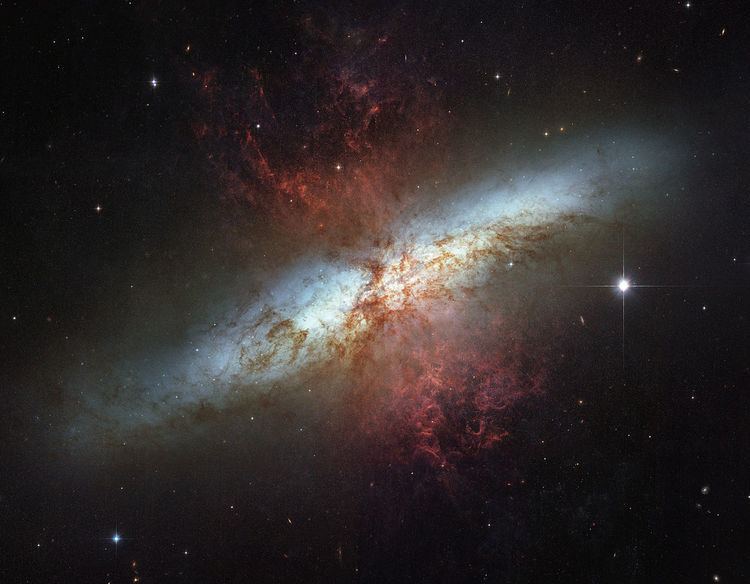
M82 messier 82 galaxy zoom animation into
Structure
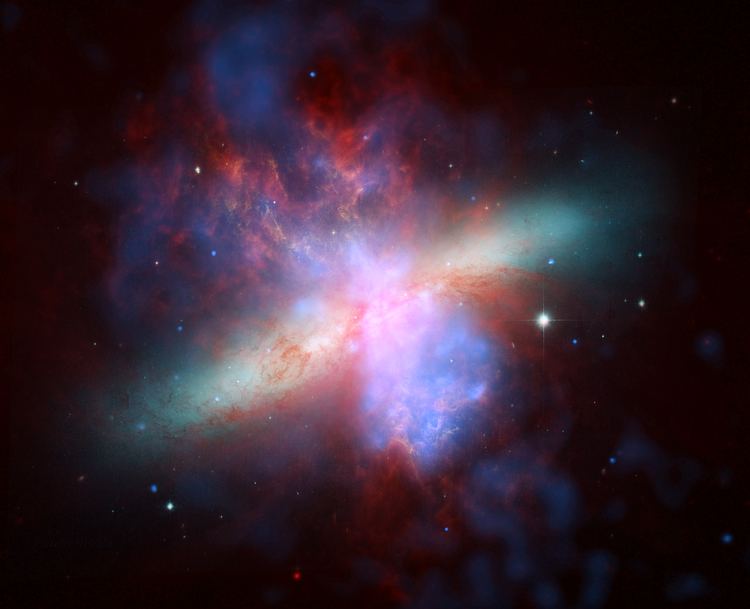
M82 was previously believed to be an irregular galaxy. In 2005, however, two symmetric spiral arms were discovered in near-infrared (NIR) images of M82. The arms were detected by subtracting an axisymmetric exponential disk from the NIR images. Even though the arms were detected in NIR images, they are bluer than the disk. The arms were previously missed due to M82's high disk surface brightness, the nearly edge-on view of this galaxy (~80°), and obscuration by a complex network of dusty filaments in its optical images. These arms emanate from the ends of the NIR bar and can be followed for the length of 3 disc scales. Assuming that the northern part of M82 is nearer to us, as most of the literature does, the observed sense of rotation implies trailing arms.
Starburst region
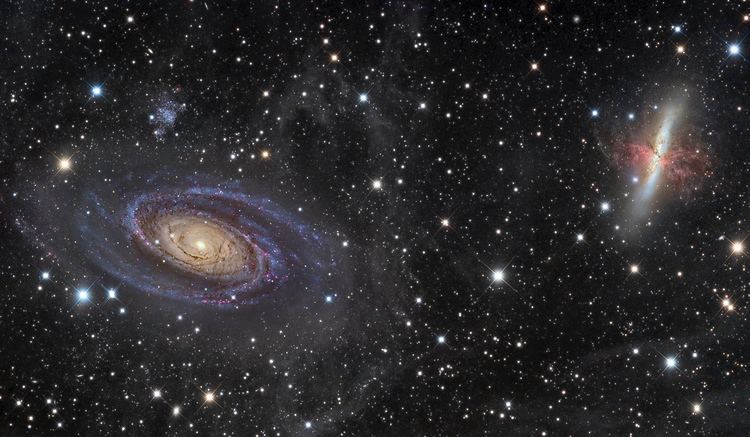
In 2005, the Hubble Space Telescope revealed 197 young massive clusters in the starburst core. The average mass of these clusters is around 200,000 solar masses, hence the starburst core is a very energetic and high-density environment. Throughout the galaxy's center, young stars are being born 10 times faster than they are inside the entire Milky Way Galaxy.
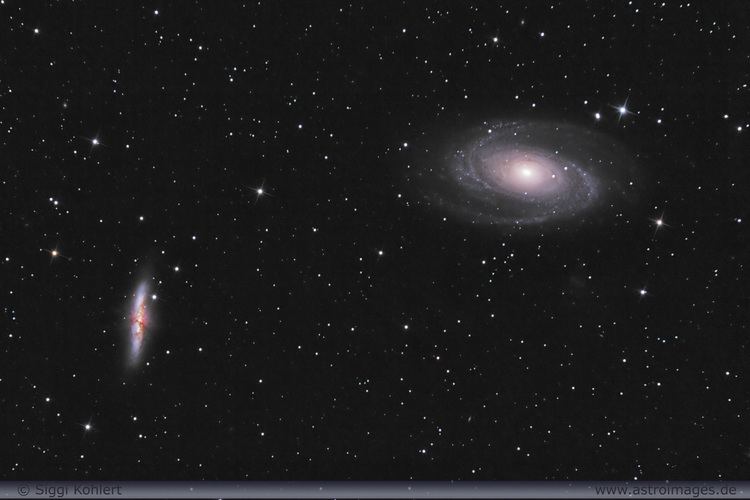
In the core of M82, the active starburst region spans a diameter of 500 pc. Four high surface brightness regions or clumps (designated A, C, D, and E) are detectable in this region at visible wavelengths. These clumps correspond to known sources at X-ray, infrared, and radio frequencies. Consequently, they are thought to be the least obscured starburst clusters from our vantage point. M82's unique bipolar outflow (or 'superwind') appears to be concentrated on clumps A and C and is fueled by energy released by supernovae within the clumps which occur at a rate of about one every ten years.
The Chandra X-ray Observatory detected fluctuating X-ray emissions from a location approximately 600 light-years away from the center of M82. Astronomers have postulated that this fluctuating emission comes from the first known intermediate-mass black hole, of roughly 200 to 5000 solar masses. M82, like most galaxies, hosts a supermassive black hole at its center with a mass of approximately 3 x 107 solar masses as measured from stellar dynamics.
Unknown object
In April 2010, radio astronomers working at the Jodrell Bank Observatory of the University of Manchester in the UK reported an object in M82 that had started sending out radio waves, and whose emission did not look like anything seen anywhere in the universe before.
There have been several theories about the nature of this object, but currently no theory entirely fits the observed data. It has been suggested that the object could be an unusual "micro quasar", having very high radio luminosity yet low X-ray luminosity, and being fairly stable, it could be an analogue of the low X-ray luminosity galactic microquasar SS 433. However, all known microquasars produce large quantities of X-rays, whereas the object's X-ray flux is below the measurement threshold. The object is located at several arcseconds from the center of M82 which makes it unlikely to be associated with a supermassive black hole. It has an apparent superluminal motion of four times the speed of light relative to the galaxy center. Apparent superluminal motion is consistent with relativistic jets in massive black holes and does not indicate that the source itself is moving above lightspeed.
Starbursts
M82 is being physically affected by its larger neighbor, the spiral M81. Tidal forces caused by gravity have deformed M82, a process that started about 100 million years ago. This interaction has caused star formation to increase tenfold compared to "normal" galaxies.
M82 has undergone at least one tidal encounter with M81 resulting in a large amount of gas being funneled into the galaxy's core over the last 200 Myr. The most recent such encounter is thought to have happened around 2–5×108 years ago and resulted in a concentrated starburst together with a corresponding marked peak in the cluster age distribution. This starburst ran for up to ~50 Myr at a rate of ~10 M⊙ per year. Two subsequent starbursts followed, the last (~4–6 Myr ago) of which may have formed the core clusters, both super star clusters (SSCs) and their lighter counterparts.
Stars in M82's disk seem to have been formed in a burst 500 million years ago, leaving its disk littered with hundreds of clusters with properties similar to globular clusters (but younger), and stopped 100 million years ago with no star formation taking place in this galaxy outside the central starburst and, at low levels since 1 billion years ago, on its halo. A suggestion to explain those features is that M82 was previously a low surface brightness galaxy where star formation was triggered due to interactions with its giant neighbor.
Ignoring any difference in their respective distances from the Earth, the centers of M81 and M82 are visually separated by about 130,000 light-years. The actual separation is 7021283821914177424♠300+300
−200 kly.
2014 supernova
On 21 January 2014 at 19.20 UT, a previously unseen star was observed in M82 at magnitude +11.7 by Dr. Steve J. Fossey, along with a team of 4 of his students, at University College London's training observatory, the University of London Observatory. It had brightened to magnitude +10.9 by 23 January. Examination of earlier observations of M82 found the supernova to be present on 15, 16, 17, 19, 20 and 22 January, brightening from magnitude +14.4 to +11.3; there was no sign of it, to limiting magnitude +17, on 14 January. It was initially suggested that it could become as bright as magnitude +8.5, well within the visual range of small telescopes and large binoculars, but it actually peaked at a rather fainter +10.5 on 31 January 2014. Preliminary analysis classified it as "a young, reddened type Ia supernova". The International Astronomical Union (IAU) has designated it SN 2014J. SN 2014J is one of the closest supernovae to Earth observed in recent decades. SN 1993J was at a very similar distance, in M82's larger companion galaxy M81, and SN 1987A in the Large Magellanic Cloud was much closer. 2014J is the closest type Ia supernova since SN 1972E.
